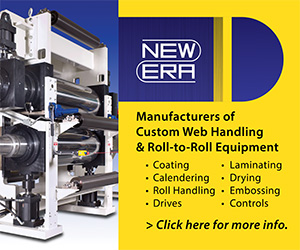Sticking With It | Hot Melt PSA Primer
- Published: March 27, 2018, By Ingrid Brase
Adhesives expert Ingrid Brase explains how hot melt pressure-sensitive products are created.
 My last offering explored the chemistry of acrylic polymers; now we move on to hot melts. As with acrylics, understanding the basic building blocks of how hot melt pressure-sensitive adhesives (HMPSA) are built will provide insight into how these products function in end use as well as an understanding of when they should be the technology of choice versus acrylics.
My last offering explored the chemistry of acrylic polymers; now we move on to hot melts. As with acrylics, understanding the basic building blocks of how hot melt pressure-sensitive adhesives (HMPSA) are built will provide insight into how these products function in end use as well as an understanding of when they should be the technology of choice versus acrylics.
As their name implies, hot melt adhesives will “melt” or liquefy when subjected to heat. The products are melted to apply to surfaces and become solid as they cool to room temperature. This provides a convenient method to create the pressure-sensitive laminate with no water or solvent to evaporate, allowing for rapid coating.
So, let’s start by listing the major components of a hot melt pressure-sensitive and how they contribute to the performance of the adhesive. We will then take a closer look at each component in more detail.
FORMULATIONS
HMPSA’s are formulated products, that is, they are blends of various polymers and chemicals. A typical HMPSA will be formulated with the following:
- Rubber: film former, provides cohesive strength
- Tackifier: provides tack and adhesion
- Diluents/Process Oils: reduces viscosity, aids wet-out
- Antioxidant: adds stability
- Other Additives: pigments, dyes, etc.
Hot melts typically are formulated in their molten or liquid form at high temperature. They are then poured into drums or film pouches and allowed to cool and solidify. The solid product is shipped to the user who will re-melt the product to coat it.
RUBBER
The rubber component of the HMPSA acts as a matrix or carrier for the other ingredients of the adhesive. It is also the primary film former and provides the cohesive strength of the product. Synthetic rubbers referred to as styrene block copolymers (SBCs) are the most commonly used rubbers. As their name implies, these polymers contain styrene, which adds hardness, and an elastomeric or “rubbery” component. The most commonly used elastomeric monomers are isoprene, butadiene, and ethylene.
SBCs are polymerized using a process called anionic polymerization, which allows the chemist to create regions rich in styrene and blocks of the elastomers. Varying these monomer blocks as well as the molecular weight provides tools for creating a portfolio of rubber components that the chemist can use to vary and control performance of the HMPSA. SBCs are widely used because they provide good strength, balance of hardness/elasticity, and also have lower viscosities allowing for easier processing. SBCs are usually 35%-50% of the HMPSA formulation.
TACKIFIERS
Tackifiers provide tack and adhesion qualities to the adhesive. They are lower molecular weight polymers with high glass transition (Tg) temperatures, generally above room temperature.
There are three broad classes of tackifiers: rosin esters, hydrocarbon resins, and terpene resins. Terpene resins are derived from wood or citrus. They are very versatile but are higher cost as there is limited supply. Rosin esters are derived from tree stumps (wood rosin), sap (gum rosin) or are by-products of the paper making process (tall oil rosin). Hydrocarbon resins are made from petroleum feedstocks and are either aliphatic or aromatic (containing ringed compounds like styrene).
The key criteria for tackifier selection is compatibility with the rubber component. Other factors that must be considered include stability, color, softening point, and odor. Many tackifiers are distinct brown or yellow colors. They can be processed to be clear; this adds expense to the product.
For instance, hydrocarbon resins will generally contain many double bonds in their backbones, which help to impart a yellow cast to the product and are sites for oxidation or degradation of the molecule. Chemists will react these hydrocarbons to hydrogenate or reduce the double bonds to single bonds. This reduces color and adds stability but also makes the hydrogenated hydrocarbons more expensive. Generally, lower color translates to higher cost.
“Water-white” resins are used for applications in medical, hygiene, and clear-on-clear beverage labelling where there is an absolute need for these higher cost tackifiers. Many hot melt formulations can contain more than one tackifier type. Formulation chemists can use combinations to achieve desired performance properties such as specific adhesion or stability. Tackifiers comprise 25%–60% of typical HMPSA formulas.
Diluents/Process Oils
Diluents or process oils are usually 5%–25% of the HMPSA formula. As their name implies, they are used to facilitate easy processing of the adhesive, reducing viscosity of the molten formula. In addition to helping in the manufacturing process, they aid in wet out on surfaces as well as cold temperature resistance by lowering the glass transition temperature, Tg.
Process oils are also one of the least expensive components of the formula, so they also help reduce the final cost of the product. Process oils are derived from petroleum and are referred to by the largest component in the mixture. Napthalenic oils are the most compatible as well as the most expensive. Paraffinic oils are also used.
Care must be taken when using these oils to ensure they are truly compatible with the other components. Over time they will separate from the formula, migrating to the surface. In end use, this results in oil blotches referred to as staining. In some instances, low molecular weight plasticizers like butyl benzyl phthalate also can be used to soften the adhesive mass and improve surface tack.
Antioxidants
All of the formulation components discussed are subject to degradation from atmospheric oxygen. This severely limits the applications where hot melts can be used as most do require a reasonable shelf life for the finished product. Antioxidants are added to improve both in-process as well as longer-term stability of the finished adhesive. Typical antioxidants used include phenols, amines, thioesters, and phosphites. They act as sites for reaction with the oxygen thus protecting other components. Since they are used at very low levels, typically less than 5%, they do not have a dramatic effect on the performance properties of the adhesive.
Other Additives
Other additives can be formulated in the HMPSA to achieve desired end-use properties. Pigments or dyes may be added to match color of the substrate or facestock. Biocides or flame retardants also have been formulated into a HMPSA. These will dilute the pressure-sensitive performance of the adhesive and also can impact shelf life, so care must be taken when considering additives.
TESTING
Like acrylics, the adhesive manufacturer carries out quality assurance testing to ensure batch-to-batch consistency of their products as well as performance. Incoming raw material testing or certification is used for the various components. Viscosity, melting point, and pressure-sensitive performance testing are all carried out on the end product.
During the development phase, the formulating chemist also will conduct aging in use evaluations. For paper labels, accelerated aging to determine potential oil separation, which will cause staining, is conducted. For clear-on-clear labels, specific ASTM test methods are conducted to determine potential yellowing when exposed to various environmental conditions. For tapes, shear adhesion with temperature cycling, i.e., hot-cold-hot, may be conducted.
In summary, hot melt pressure-sensitive adhesives represent a cost effective, easy to apply option. They provide excellent adhesion to plastic surfaces and rapid wet-out on surfaces. This makes them an ideal choice for labels. The ability to easily create thick films also is an attractive characteristic in many tape applications. Key limitation for hot melt products is their heat stability. The very characteristic that makes them easy to apply, that is, coatability at high temperature, limits their end-use applications. These adhesives are not smart enough to realize they should not soften and melt when subjected to high temperature in end use!
So now, hopefully, you have a slightly better understanding of how hot melt pressure-sensitive products are created. In the first article in this series, we explored acrylics, next time we will take a closer look at water-based acrylics or emulsions. Meanwhile, I hope you keep Sticking With It….
About the Author
Ingrid Brase is a technical market strategist recognized for her ability to translate technical needs into business solutions. Her understanding of pressure-sensitive adhesives and their use is complemented by her strengths in strategic marketing, project management, new product development, and key account management. She is available for consulting or contact assignments in these areas. Ingrid’s expertise is a result of more than 20 years of experience in the p-s adhesives business. She was most recently the market segment director for Henkel Corp., rising to that position after various assignments in the p-s business unit. She began her career as a research scientist then progressed to market-focused roles. Ingrid earned her MBA at Rider Univ. and holds a BS in chemistry from SUNY/Oneonta. She has served on the board of directors for TLMI and AIMCAL in addition to chairing technical teams for both trade associations. Ingrid is a well-known speaker and author on topics related to adhesive use. To learn more about Ingrid or contact her, visit www.ingridbrase.com, e-mail to ingrid.brase1@gmail.com, or call her at 609-558-9760.







